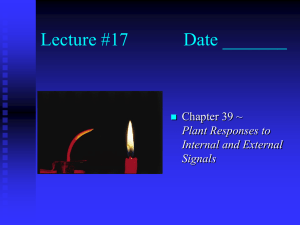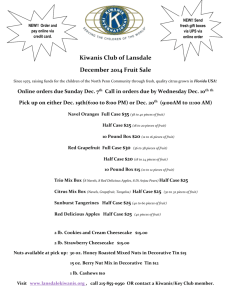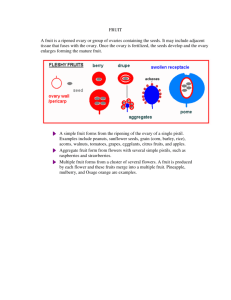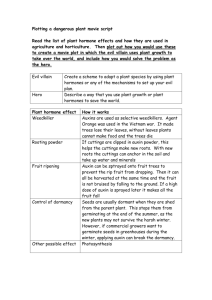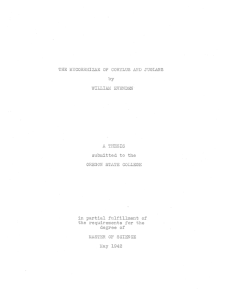AP Biology Study Guide Structure & Function of Plants Ch. 35
advertisement
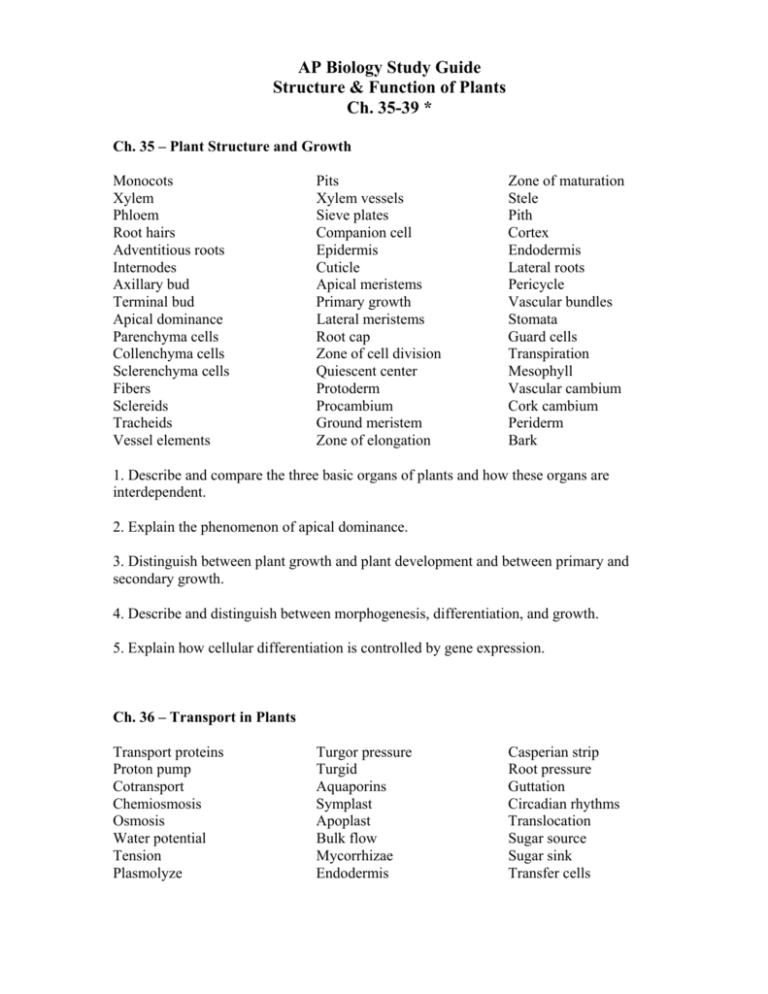
AP Biology Study Guide Structure & Function of Plants Ch. 35-39 * Ch. 35 – Plant Structure and Growth Monocots Xylem Phloem Root hairs Adventitious roots Internodes Axillary bud Terminal bud Apical dominance Parenchyma cells Collenchyma cells Sclerenchyma cells Fibers Sclereids Tracheids Vessel elements Pits Xylem vessels Sieve plates Companion cell Epidermis Cuticle Apical meristems Primary growth Lateral meristems Root cap Zone of cell division Quiescent center Protoderm Procambium Ground meristem Zone of elongation Zone of maturation Stele Pith Cortex Endodermis Lateral roots Pericycle Vascular bundles Stomata Guard cells Transpiration Mesophyll Vascular cambium Cork cambium Periderm Bark 1. Describe and compare the three basic organs of plants and how these organs are interdependent. 2. Explain the phenomenon of apical dominance. 3. Distinguish between plant growth and plant development and between primary and secondary growth. 4. Describe and distinguish between morphogenesis, differentiation, and growth. 5. Explain how cellular differentiation is controlled by gene expression. Ch. 36 – Transport in Plants Transport proteins Proton pump Cotransport Chemiosmosis Osmosis Water potential Tension Plasmolyze Turgor pressure Turgid Aquaporins Symplast Apoplast Bulk flow Mycorrhizae Endodermis Casperian strip Root pressure Guttation Circadian rhythms Translocation Sugar source Sugar sink Transfer cells 1. Describe the role and importance of proton pumps in transport across plant membranes. 2. Define cotransport and chemiosmosis. 3. Define osmosis and water potential and explain how water potential is measured. 4. Describe the three routes available for lateral transport in plants. 5. Relate the structure of sieve-tube cells, vessel cells, and tracheids to their function in bulk flow. 6. Explain how the structure of root hairs promotes their functions. Explain how mycorrhizae facilitate the functions of roots. 7. Explain how transport of xylem sap occurs. 8. Explain how and when stomata open and close. 9. Explain how xerophytes reduce transpiration. 10. Define and describe the process of translocation. 11. Trace the path of phloem sap from the primary sugar source to common sugar sinks. Chapter 37 – Plant Nutrition Mineral nutrients Essential nutrient Macronutrient Micronutrient Topsoil Horizons Loams Humus Cation exchange Sustainable agriculture Nitrogen-fixing bacteria Nitrogen fixation Nitrogenase Leghemoglobin Nodules Bacteroids Mycorrhizae Ectomycorrhizae 1. Distinguish between macronutrients and micronutrients. List each and describe their importance in normal plant structure and metabolism. 2. Define cation exchange, explain why it is necessary for plant nutrition, and describe how plants can stimulate the progress. 3. Describe the important role of nitrogen-fixing bacteria. 4. Explain how a legume species recognizes a certain species of Rhizobium and explain how that encounter leads to the development of a nodule. 5. Define mycorrhizae and explain why they are considered examples of mutualism. 6. Explain how mycorrhizae enhance plant nutrition. 7. Describe the modifications for nutrition that have evolved among plants, including parasitic plants, carnivorous plants, and mycorrhizae. Chapter 38 – Plant Reproduction and Development Alteration of generations Sporophyte Gametophytes Sepals Petals Stamens Carpels Complete flowers Incomplete flowers Perfect flower Imperfect flower Monoecious Dioecious Microspores Mega spore Embryo sac Pollination Self-incompatibility Endosperm Double fertilization Seed coat Hypocotyl Radicle Epicotyl Coleoptile Fruit Pericarp Simple fruit Aggregate fruit Multiple fruit Imbibition Vegetative reproduction Fragmentation Apomixis Scion Protoplast fusion Monoculture Morphogenesis Cellular differentiation Preprophase band Pattern formation Positional formation Meristem identity genes Organ-identity genes 1. Outline the angiosperm life cycle. 2. Distinguish between pollination and fertilization. 3. Explain the adaptive advantage of double fertilization in angiosperms. 4. Explain how a monocot and dicot seed differ. 5. Explain how fruit forms and ripens. List the functions of fruit. 6. Describe the natural mechanisms of vegetative reproduction in plants, including fragmentations and apomixes 7. Compare traditional plant-breeding techniques and genetic engineering, noting similarities and differences. Ch. 39 – Control Systems in Plants Hormones Phototropism Auxin Gibberellin Abscisic acid (ABA) Oligosaccharins Brassinosteroids Tropisms Gravitropism Statoliths Thigmotropism Thigmomorphogenesis Action potentials Sleep movements Circadian rhythm Photoperiodism Short-day plants Long-day plants Day-neutral plants Phytochromes Heat-shock proteins Phytoalexins Hypersensitive response Systemic acquired resistance (SAR) 1. List six classes of plant hormones, describe their major functions, and note where they are produced in the plant. 2. Explain how the ratio of cytokinin to auxin affects cell division and cell differentiations. 3. Describe how stem elongation and fruit growth depend on a synergism between auxin and gibberellins. 4. Describe the effects of ABA on seed dormancy and drought stress. 5. Describe the role of ethylene in the triple response to mechanical stress, apoptosis leaf abscission, and fruit ripening. 6. Describe the functions of brassinosteroids in plants. 7. Define circadian rhythm and explain what happens when an organism is artificially maintained in a constant environment. 8. Distinguish between short-day, long-day, and day-neutral plants. Explain why these names are misleading. 9. Explain how flowering might be controlled and what is necessary for flowering to occur. 10. Provide a plausible explanation for how a stimulus that causes rapid leaf movement can be transmitted through the plant. 11. Explain how plants deter herbivores with physical and chemical defenses. 12. Describe the multiple ways that plants defend against pathogens. * All questions modified from www.campbellbiology.com
